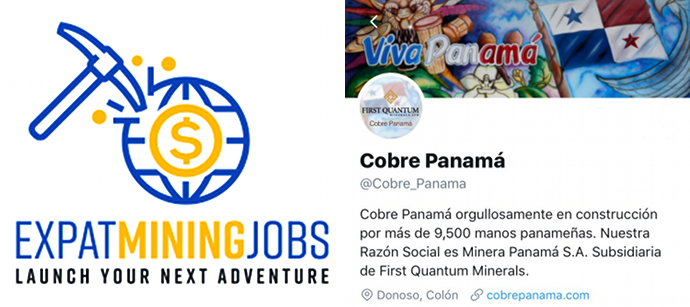One public version in English, another in Spanish, a third for the government. Panamanian labor law says that no more than 10 percent of a company work force in this country can be non-citizens. But PRD legislator Crispiano Adames alleges that of nearly 10,000 people who are or were employed in building the copper mine in Donsoso, only 1,300 were or are Panamanian. The company created a company union with its mostly imported work force, was opposed by Panama’s SUNTRACS construction workers’ union and then demanded government intervention to smash SUNTRACS. The company lost that strike and legal dispute but tensions persist. Minera Panama ads from online.
After 22 years, an always dubious contract is rejected — for now
by Eric Jackson
Back in 1997, a remnant of the one of the two parties with which Panama started as an independent republic in 1903, the Liberal Party, was playing the usual small party game that’s played here. There were a junior partner in a PRD government that had come into office with just a little more than one-third of the vote. The object of such alliances are neither ideological nor about any particular policy imperative — they are business propositions about jobs, contracts and concessions for their leading members. And US-educated Canadian and Panamanian dual citizen, Richard Fifer, seemed to have hit the jackpot.
Fifer got a mining concession, for gold, silver and copper, in western Colon province’s Donoso district and some adjacent parts of Cocle province. While a 1969 decree had set a minimum royalty of 6% on the value of all metals extracted from Panamanian territory, Fifer’s concession set the royalty at 2% of gross sales. At the time, few expected that there would be any actual mining, that it was all about stock swindles on Canadian exchanges. Those did happen but eventually one small part of the concession became the Petaquilla gold mine.
Starting with the birders, environmentalists were appalled. People living downstream from the project, the river that they fished and bathed in now muddy and allegedly tainted with mining chemicals, soon joined in the outcry.
For a time the gold mine created a spike in Panamanian industrial production figures, as gold was poured and exported.
And on the cost side of the ledger? The environmental impact study for the project was a prototypical bad joke, but there were other established laws, which Fifer said by contract did not apply. He lost that one in court but by and large didn’t do the things required to protect the environment from muddy runoff from deforested land, toxic runoff from chemicals used to separate gold from the rocks in which it is embedded and the social effects which Panama’s environmental studies never really contemplate. Plus, payments into the Seguro Social health care and pension system were deducted from workers’ paychecks but never turned over to the government agency.
Meanwhile, Fifer had other businesses to look after. The Liberals, in their governmental swan song, switched alliances to the Arnulfistas (now, as earlier, called the Panameñistas.) For that switcheroo Fifer got to be governor of Cocle province in the Moscoso administration. Eventually he was removed from that post by the demand of his own party, and after the next government came in the Comptroller General noted the disappearance of foreign aid funds for a museum in Penonome and a bunch of no-show employees who were on the gobernacion’s books. From the governor’s office Fifer got a somewhat lateral transfer to the Panama Canal Authority, under the then Minister of Canal Affairs, one Ricardo Martinelli.
Fifer was in the political out crowd during the following Martín Torrijos administration, but was influential enough so that when criminal charges were threatened over the missing museum funds he went underground for a few days to avoid arrest, raised the missing money and paid it back, such that he was allowed to go on his merry way. The payroll issue lingers to this day — he was slated to go on trial for that last October but it seems that illness put the case off for the foreseeable future.
And the gold mine project proceeded, with alarms being sounded from several quarters.
In the Martinelli administration came gold production, the international pump and dump stock swindle that the ex-president ran with Petaquilla shares, an eventually abortive deal with Spain’s Andalusia region to revive an old Roman gold mine, financial collapse but before that the separation and sale of most of the concession to international mining companies, first to INMET, which in turned flipped to First Quantum, the parent company of the current copper mine project.
The copper mine is a much larger and more serious proposition. No minor league flim flam here — world copper prices have rebounded and First Quantum is serious about extracting and selling it. But it all rests on the 1997 contract.
Nearby farmers say that they piva palms, on which they depended for both food and cash, no longer fruit. If the burden of proof is upon them to establish a link with the mine, they don’t have the resources or access to do that. But a huge chunk of the Meso-American Wildlife Corridor that was established by treaty among seven nations has been, as the Panamanian euphemism would have it, “cleaned.” Might the messy living things swept away been the tiny creatures that pollinated the piva palms? That’s one hypothesis.
Environmentalists, most especially the Environmental Litigation Center (CIAM), have been in court. Not especially about the pivas, but about the flawed 1997 environmental permit, especially now that First Quantum has found molybdenum in the mix and plans to separate out and sell that precious substance that among other things is used for electrical conducting ink on computer circuit boards.
CIAM’s claim was that the environmental issues of mining and separating gold are one things, copper another, and molybdenum — unmentioned in the original concession contract — is yet a third set of problems. As in, First Quantum, whose copper mine is set to go into production within a few weeks, is operating on an invalid environmental permit.
Last fall the Supreme Court agreed with CIAM and struck down the 1997 concession contract. However, the Varela administration and First Quantum treated that as a minor glitch and mine construction work continued.
The legal fix was to pass a retroactive law to legalize what had been done more than 20 years ago. That’s what President Varela put on the special legislative session agenda, and which the lame duck Economy and Finance Committee rejected by a 6-0 vote, with one abstention, on May 29. That idea is dead.
Or shall we say dormant? The Vice President-elect, José Gabriel Carrizo, was the lawyer for Petaquilla when the original concession contract went through. President-elect Nito Cortizo is trying to be friends with the Chamber of Commerce and other business groups that are screaming about the legal security of foreign investments in the wake of last year’s court decision and the the legislature’s rejection of Varela’s fix. The hole in the ground is about to start creating copper and money. Look for the incoming administration to renegotiate rather than cancel.
It should actually be a test of Cortizo’s business acumen. If, as many claim, First Quantum had broken Panamanian labor laws and given grossly inaccurate numbers in its defense, think about what that might mean. If it’s two percent, or six percent, of gross sales that are owed to Panama, by whose count? The company had this sort of problem with Zambia, which claimed that it had been short-changed by billions. There are ways for governments to monitor such things, even in the face of ideological objections that looking after the public revenue is anti-business.
These links are interactive — click on the boxes













